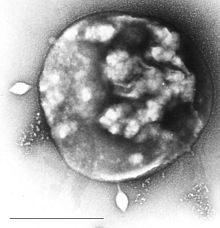Sulfolobus facts for kids
Quick facts for kids Sulfolobus |
|
|---|---|
 |
|
| Electron micrograph of Sulfolobus infected with Sulfolobus virus STSV1. Bar = 1 μm. | |
| Scientific classification | |
| Domain: | |
| Kingdom: | |
| Phylum: | |
| Class: |
Thermoprotei
|
| Order: |
Sulfolobales
|
| Family: |
Sulfolobaceae
|
| Genus: |
Sulfolobus
Brock, Brock, Belly & Weiss 1972
|
| Type species | |
| Sulfolobus acidocaldarius Brock et al. 1972
|
|
| Species | |
|
|
Sulfolobus is a type of tiny living thing, a microorganism, that belongs to a special group called archaea. It's part of the family Sulfolobaceae.
These amazing creatures live in very hot places. You can find them in volcanic springs. They like temperatures around 75-80 °C (that's super hot!) and very acidic water, like pH 2-3. This means they are both acidophiles (acid-lovers) and thermophiles (heat-lovers).
Sulfolobus cells have an irregular shape. They also have tiny whip-like tails called flagella that help them move around.
Many Sulfolobus species are named after where they were first found. For example, Sulfolobus solfataricus was discovered near the Solfatara volcano. You can find other species in volcanic areas worldwide, including places called mud pots.
Contents
Studying DNA with Sulfolobus
Scientists use Sulfolobus to learn about how DNA works. DNA is like the instruction manual for all living things. In 1996, scientists looked at the DNA of another archaea, Methanococcus jannaschii. They found that its genes for making copies of DNA were more like those in complex living things (eukaryotes) than in simple bacteria (other prokaryotes).
Later, in 2001, the DNA of Sulfolobus solfataricus was studied. It also had DNA copying genes similar to eukaryotes. These genes include important parts like DNA polymerase and PCNA.
In 2004, scientists found that Sulfolobus has two starting points for copying its DNA. This was a big discovery because most simple cells only have one. Because Sulfolobus has a simpler DNA copying system than eukaryotes, it helps scientists understand the more complex process in our own cells.
Sulfolobus in Technology
The proteins from Sulfolobus are special because they can handle extreme heat. This makes them useful in biotechnology and industry. For example, scientists can make artificial parts called affitins from S. acidocaldarius proteins.
Sulfolobus gets its energy from sulfur. It can either get energy from chemicals (chemoheterotrophic) or make its own food (lithoautotrophic). They use sulfur to help them breathe at a tiny level, like how we use oxygen. For example, S. tokodaii can turn hydrogen sulfide into sulfate inside its cells.
Genome Information
Scientists have fully mapped the DNA (called the genome) of some Sulfolobus species. For example, the genome of S. acidocaldarius has over 2.2 million nucleotides (the building blocks of DNA). S. solfataricus has almost 3 million, and S. tokodaii has about 2.7 million.
All these species have a circular chromosome, which is like a loop of DNA. They also have parts of their DNA that suggest they have a system similar to the TCA cycle found in our own cells' powerhouses (mitochondria).
Cell Structure and How it Lives
Sulfolobus can get energy in two main ways. It can oxidize (break down) sulfur, or it can use sulfur to break down simple carbon compounds. This second way only works when oxygen is around. Its main ways of getting energy are similar to pathways found in many other living things.
All archaea have special fats in their cell membranes. These fats have "ether links" which make them very strong and resistant to heat and acid. Sulfolobus is known for even more unusual fats called "tetraether lipids." These lipids connect across the entire cell membrane, making it super tough. This helps Sulfolobus survive in its extremely hot and acidic home.
Where Sulfolobus Lives
S. solfataricus has been found in many places around the world. These include Yellowstone National Park in the USA, Mount St. Helens, Iceland, Italy, and Russia. Basically, you can find Sulfolobus almost anywhere there is volcanic activity. They love places where the temperature is around 80 °C, the pH is about 3, and there's plenty of sulfur.
Another species, S. tokodaii, was found in an acidic hot spring in Beppu Hot Springs, Kyushu, Japan. Scientists have also found signs of Sulfolobus-like archaea deep under the seafloor!
Sulfolobus and Viruses
Some viruses infect Sulfolobus. These viruses can't survive the extreme heat and acid on their own. So, they use Sulfolobus as a safe place to live and make copies of themselves. It's like the Sulfolobus acts as a shield for the virus against the harsh environment.
These viruses are called "temperate" or "permanent lysogens." This means they can live inside the Sulfolobus cell without immediately destroying it. Unlike some viruses that burst out of their host cells, these viruses can stay inside Sulfolobus and keep replicating. This special relationship helps the viruses survive in such tough conditions.
See also
 In Spanish: Sulfolobus para niños
In Spanish: Sulfolobus para niños

